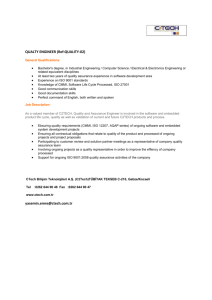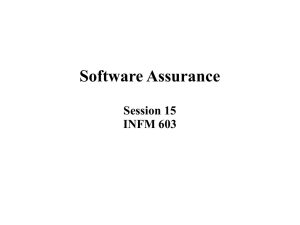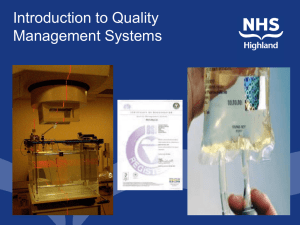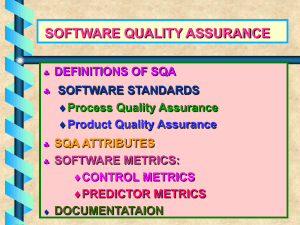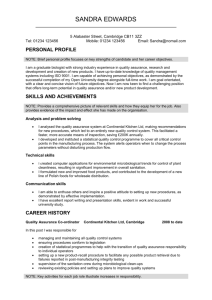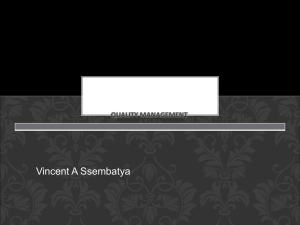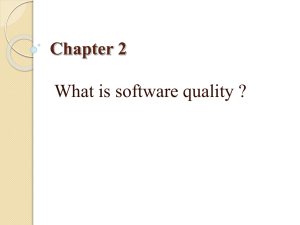Software Quality Control - Sheffield Hallam University
advertisement
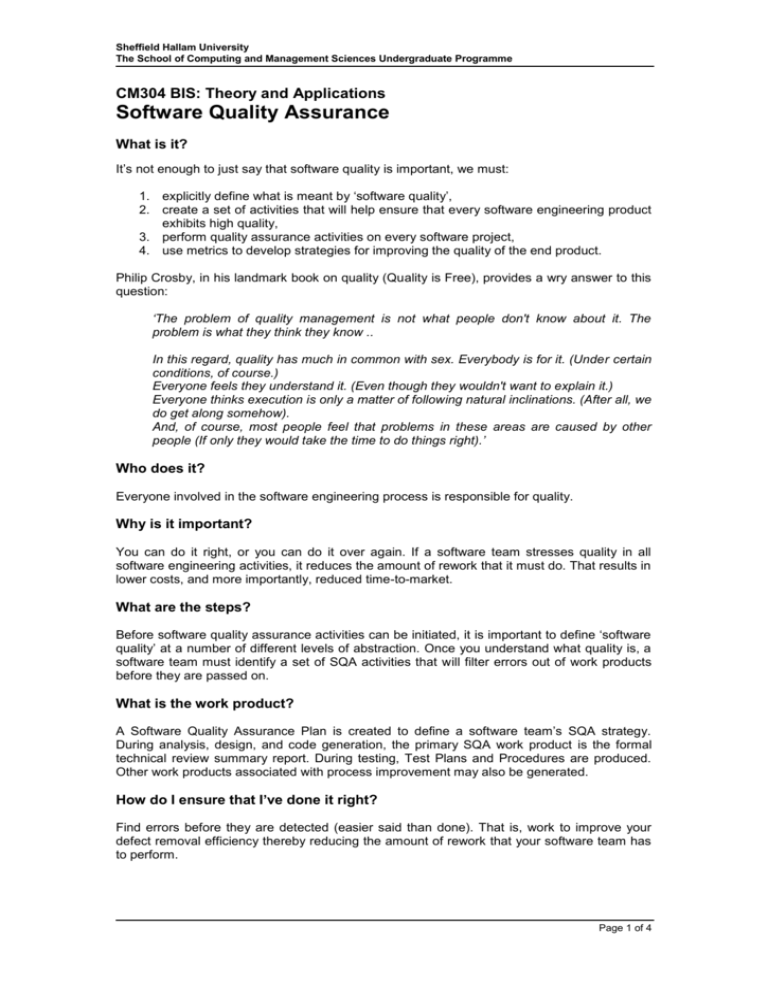
Sheffield Hallam University The School of Computing and Management Sciences Undergraduate Programme CM304 BIS: Theory and Applications Software Quality Assurance What is it? It’s not enough to just say that software quality is important, we must: 1. explicitly define what is meant by ‘software quality’, 2. create a set of activities that will help ensure that every software engineering product exhibits high quality, 3. perform quality assurance activities on every software project, 4. use metrics to develop strategies for improving the quality of the end product. Philip Crosby, in his landmark book on quality (Quality is Free), provides a wry answer to this question: ‘The problem of quality management is not what people don't know about it. The problem is what they think they know .. In this regard, quality has much in common with sex. Everybody is for it. (Under certain conditions, of course.) Everyone feels they understand it. (Even though they wouldn't want to explain it.) Everyone thinks execution is only a matter of following natural inclinations. (After all, we do get along somehow). And, of course, most people feel that problems in these areas are caused by other people (If only they would take the time to do things right).’ Who does it? Everyone involved in the software engineering process is responsible for quality. Why is it important? You can do it right, or you can do it over again. If a software team stresses quality in all software engineering activities, it reduces the amount of rework that it must do. That results in lower costs, and more importantly, reduced time-to-market. What are the steps? Before software quality assurance activities can be initiated, it is important to define ‘software quality’ at a number of different levels of abstraction. Once you understand what quality is, a software team must identify a set of SQA activities that will filter errors out of work products before they are passed on. What is the work product? A Software Quality Assurance Plan is created to define a software team’s SQA strategy. During analysis, design, and code generation, the primary SQA work product is the formal technical review summary report. During testing, Test Plans and Procedures are produced. Other work products associated with process improvement may also be generated. How do I ensure that I’ve done it right? Find errors before they are detected (easier said than done). That is, work to improve your defect removal efficiency thereby reducing the amount of rework that your software team has to perform. Page 1 of 4 Sheffield Hallam University The School of Computing and Management Sciences Undergraduate Programme Software Quality Assurance Some software developers continue to believe that software quality is something you begin to worry about after code has been generated. Nothing could be further from the truth. Software quality assurance (SQA) is an umbrella activity that is applied throughout the software process. SQA encompasses: 1. 2. 3. 4. 5. 6. a quality management approach, effective software engineering technology (methods and tools), formal technical reviews that are applied throughout the software process; a multi-tiered testing strategy, control of software documentation and the changes made to it, a procedure to ensure compliance with software development standards (when applicable), 7. measurement and reporting mechanisms. It has been said that no two snowflakes are alike. Certainly when we watch snow falling it is hard to imagine that snowflakes differ at all, let alone that each flake possesses a unique structure. In order to observe differences between snowflakes, we must examine the specimens closely, perhaps using a magnifying glass. In fact, the closer we look, the more differences we are able to observe. This phenomenon, variation between samples, applies to all products of human as well as natural creation. For example, if two "identical" circuit boards are examined closely enough, we may observe that the copper pathways on the boards differ slightly in geometry, placement, and thickness. In addition, the location and diameter of the holes drilled in the boards varies as well. Variation control is the heart of quality control. A manufacturer wants to minimize the variation among the products that are produced, even when doing something relatively simple like duplicating diskettes. Surely, this cannot be a problem - duplicating diskettes is a trivial manufacturing operation, and we can guarantee that exact duplicates of the software are always created. Or can we? We need to ensure the tracks are placed on the diskettes within a specified tolerance so that the overwhelming majority of disk drives can read the diskettes. In addition, we need to ensure the magnetic flux for distinguishing a zero from a one is Sufficient for read/write heads to detect. The disk duplication machines can, and do, wear and go out of tolerance. So even a ‘simple’ process such as disk duplication may encounter problems due to variation between samples. Quality Control Quality Control (QC) is the series of inspections, reviews, and tests used throughout the software process to ensure each work product meets the requirements placed upon it. QC includes a feedback loop to the process that created the work product. The combination of measurement and feedback allows us to tune the process when the work products created fail to meet their specifications. Quality Assurance Quality Assurance (QA) consists of the auditing and reporting functions of management. The goal of quality assurance is to provide management with the data necessary to be informed about product quality, thereby gaining insight and confidence that product quality is meeting its goals. Page 2 of 4 Sheffield Hallam University The School of Computing and Management Sciences Undergraduate Programme Cost of Quality Cost of quality includes all costs incurred in the pursuit of quality or in performing quality related activities. Cost of quality studies are conducted to provide a baseline for the current cost of quality, identify opportunities for reducing the cost of quality and to provide a normalised basis of comparison. The basis of normalisation is almost always in the relevant currency. Once we have normalised quality costs on a monetary basis, we have the necessary data to evaluate where the opportunities lie to improve our processes. Furthermore, we can evaluate the affect of changes in based-based terms. Quality costs may be divided into costs associated with prevention, appraisal and failure. BS EN ISO 9001 This QA standard, which has been adopted for use by more than 130 countries, is becoming increasingly important as the predominant means whereby customers can judge the competence of a software developer. One of the problems with the ISO 9001 series standard is that it is not industry specific: it is expressed in general terms, and can be interpreted by the developers of diverse products such as ball-bearings, hair dryers, motor cars, sports equipment, and televisions, as well as software. A number of documents have been produced which relate the standard to the software industry, but do not go into a huge amount of detail. For the software industry the relevant standards are: 1. ISO 9001 Quality Systems-—Model for Quality Assurance in Design, Development, Production, Installation and Servicing. This is a standard which describes the quality system used to support the development of a product, which involves design. 2. ISO 9000-3. Guidelines for the Application of lSO 9001 to the Development, Supply and Maintenance of Software. This is a specific document, which interprets ISO 9001 for the software developer. 3. ISO 9004-2. Quality Management and Quality System Elements - Part 2. This document provides guidelines for the servicing of software facilities such as user support. It is worth looking at a small excerpt from ISO 9001. This gives the us an idea at the level at which ISO 9001 addresses the QA and development process. The extract chosen comes from section 4.11: 4.11 Inspection, measuring and test equipment The supplier shall control, calibrate and maintain inspection, measuring and test equipment, whether owned by the supplier, on loan, or provided by the purchaser, to demonstrate the conformance of product to the specified requirements. Equipment shall be used in a manner which ensures that measurement uncertainty is known and is consistent with the required measurement capability. The first thing to notice is its generality; it could apply to the developer of any product. The second thing to notice is the difficulty in interpreting the paragraph - it is obviously aimed at standard engineering processes where equipment such as thermocouples, calibration gauges and potentiometers are the norm. An interpretation of the paragraph is that the supplier shall ensure that any software tools used for testing are of at least the same quality as the software that is to be developed, and that any test equipment which produces measurement values, for example, performance monitors, has an accuracy which is acceptable when compared with the accuracy specified for performance in the requirements specification. Software quality assurance is an ‘umbrella activity’ that is applied at each step in the software process. SQA encompasses procedures for the effective application of methods and tools; formal technical reviews; testing strategies and techniques; procedures for change control; Page 3 of 4 Sheffield Hallam University The School of Computing and Management Sciences Undergraduate Programme procedures for assuring compliance to standards (such as ISO 9001), and measurement and reporting mechanisms. SQA is complicated by the complex nature of software quality – an attribute of computer programs that is defined as ‘conformance to explicitly and implicitly defined requirements’. But when considered more generally, software quality encompasses many different product and process factors and related metrics. Software reviews are one of the most important SQA activities. Reviews serve as filters throughout all software engineering activities, removing errors while they are relatively inexpensive to find and correct. The formal technical review is a stylised meeting that has been shown to be extremely effective in uncovering errors. To properly conduct software quality assurance, data about the software engineering process should be collected, evaluated and disseminated. Statistical SQA helps to improve the quality of the product and the software process itself. Software reliability models extend measurements, enabling collected defect data to be extrapolated into projected failure rates and reliability predictions. Further Reading Books by Moriguchi (Software Excellence: A Total Quality Management Guide, Productivity Press, 1997), Horch (Practical Guide to Software Quality Management, Artech Publishing, l 996) are excellent management level presentations on the benefits of formal quality assurance programs for computer software. Books by Deming and Crosby do not focus on software, but both books are must reading for senior managers with software development responsibility. Gluckman and Roome (Everyday Heroes of the Quality Movement, Dorset House,1993) humanises quality issues by telling the story of the players in the quality process. Kan (Metrics and Models in Software Quality Engineering, Addison-Wesley,1995) presents a quantitative view of software quality. Manns (Software Quality Assurance, Macmillan, 1996) is an excellent student introduction to software quality assurance. Tingley (Comparing ISO 9000, Malcolm Baldridge, and the SEI CMM for Software, Prentice-Hall, 1996) provide useful guidance for organizations that are striving to improve their quality management processes. Oskarsson (An ISO 9000 Approach to Building Quality Software, Prentice-Hall,1995) discusses the ISO standard as it applies to software. There have been dozens of books written about software quality issues in recent years. The following is a small sampling of useful sources: Clapp, PA. et al, Software Quality Control, Error Analysis and Testing, Noyes Data Corp, Park Ridge, NJ, 1995. Dunn, R.H. and R.S. Ullman, TQM for Computer Software, McGraw-Hill, 1994. Fenton, N., R. Whitty, and Y. Iizuka, software Quality Assurance and Measurement World wide Industrial Applications, Chapman & Hall, 1994. Ferdinand, A.E., Systems, Software, and Quality Engineering, Van Nostrand Reinhold, 1993. Page 4 of 4
